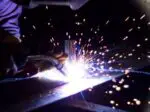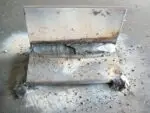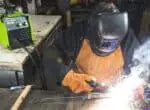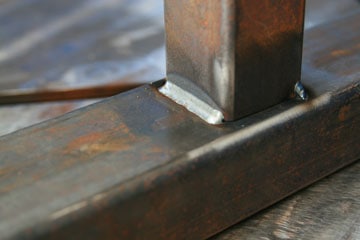 Mild steel is a metal that has a lot of specialties to it. In the welding world, it holds immense importance in regards to the ease with which it works. The incredible flexibility to work with mild steel makes it one of the most included metals in the welding works.
Mild steel is a metal that has a lot of specialties to it. In the welding world, it holds immense importance in regards to the ease with which it works. The incredible flexibility to work with mild steel makes it one of the most included metals in the welding works.
Today, we are going to discuss what gases are used in MIG weld while working with this thin low carbon metal.
To MIG weld mild steel, there are many gases used either individually or as a combination. The most commonly used out of these is C25 which is a mixture of Argon and CO2. However, there are other gases that give almost the same result, but for this, you need to know how each gas contributes to the process.
Through this blog, I have gathered enough information for you to get an idea about the same. SO DON’T STOP. Read further!
Key factors to choose the perfect gas for MIG weld of mild steel
Choosing the best gas for MIG weld is a crucial matter to get a good weld. The shielding gas used sets the atmosphere for the weld and protects it from contamination that can result in oxidation or rust.
So you see how extremely important it is to choose the right gas, don’t you? Well, let’s see what all you have to keep in mind while selecting the gas for MIG welding mild steel.
1.) Your budget: Of course, your budget matters in MIG welding. The rate of each gas differs and therefore a neat study of the rate levels needs to be done before you go for buying the gas.
While CO2 is cheap, Argon is costly; likewise, the price of each gas varies. It is better you analyse your budget and see which is the best gas that can go with it. Now this will directly take us to the next point.
2.) Disposable or Refillable Gas Cylinders: You can choose between the two based on your budget and what kind of weld you are going for your mild steel. While Refillable gas cylinders come in a variety of combinations of these two gases, disposable gas cylinders are limited to a specific ratio with CO2 to Argon as 14:86 or pure CO2.
That is all that you get from disposable gas cylinders. If you are low on budget you will surely end up choosing pure CO2 as it is one of the cheapest gas available in the market. If not this, then Argon and CO2 is the best choice as Argon has some qualities that can cover up the flaws of CO2.
Refillable gas cylinders on the other hand are much more budget-friendly. The obvious reason is of course they are refillable. Disposable cylinders can easily feel like a loss as they do not last for long and can drain your pocket if Argon is also included.
Even though the constituents are the same; it is the combination of the two that makes refillable cylinders the more attractive choice. However, with these also, pure CO2 is still an option. The different combination of Argon and CO2 is for the different levels of thickness of the metal.
3.) The thickness of the steel: Mild steel comes in various thicknesses. Thus the gas combination you choose can have a specific effect of its own. This high content of Argon can give a stable arc and help in penetration of the weld. Make sure that you understand the need for each weld to be done smoothly
| 5% Co2 + 95% Argon | 8-10mm thick |
| 8% Co2 + 92% Argon | 3mm to 15mm |
| 10% Co2+ 90% Argon | 3mm to 15mm |
| 20% Co2 + 80% Argon | thicknesses above 10mm. |
How the chosen gases for MIG welding mild steel determine my weld quality?
I have already explained how the two gases can help you in getting the desired weld. Well, this is not a thing just limited to mild steel. These are all general factors that determine the weld in MIG welding.
Before you buy gas for MIG weld, you can talk to the store manager and understand how a particular gas can contribute to the weld. If you share your requirements with them, they will help you choose the gas as well.
It is not rocket science, hence, you can easily find your gas or the combination of gas you need once you are sure of what you want. Even if you do not get a person to talk to, worry not, as MIG welders often come with a detailed explanation in the form of a gas chart that shows which gas can be used for which metal.
The gases you choose determine the weld quality mainly in three ways:
1.) The mechanical properties of the weld: Aesthetic weld is what most of us would go for. But there are also other features like the smoothness and fatigue strength of the weld that matters.
If the welding process is erratic, undercuts can happen that will badly affect the loading strength. All these can be avoided if you are a little bit careful while choosing the gas.
2.) The stability of the arc: Arc stability is a crucial matter in creating a non-erratic weld. You need to have a keen eye especially for thin metal like mild steel while selecting the gas.
Pure CO2 can result in a very unstable arc thereby giving a weld that will not be satisfactory. While Argon helps to control the arc. Gases are therefore a matter of utmost importance that can affect the whole weld
3.) How deep the weld penetrates: For mild steel, penetration is not that much of a problem. As the metal is thin, penetration can happen easily. However, this is exactly what the problem is.
With too much heat of the arc, penetration can ruin a weld with thin steel. You do not want to go overboard with the process and destroy your work. Make sure to determine the gas combination is not overwhelming for the metals.
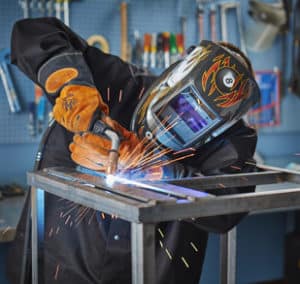
Which is the best gas for MIG welding mild steel?
Out of all the gases used for MIG weld, CO2 is the most preferred, because of its low cost. Because of this reason, no MIG welding of mild steel will happen without CO2 being a part of it.
Either it will be a component of the gas mixture or be used purely. But, what is that special combination that is the most used for MIG welding mild steel? Drum roll, please……!
C25!
Yes, C25 is like the ideal combination that brings out the best in mild steel. With carbon dioxide 25% and Argon 75%, the welding world recommends this combination to get a balanced result.
The price might be a bit too much for you, but welders prefer this mixture, as it has what it takes to give that aesthetic look that you are rooting for. But, not even C25 is perfect. There are certain cons to C25 as well. I will tell you that in the next section.
See also: Can I TIG weld mild steel with Pure Argon?
What are the pros and cons of using C25 for MIG weld mild steel?
I told you how C25 is seen as the ideal combination, but it has its flaws too. Well, let’s take a look into it. Shall we?
Pros of C25:
1.) Aesthetic weld: Mild steel is commonly used for automobiles and C25 just serves the purpose of giving a polished look to the weld. And this is why the welders prefer to use C25 in areas where the weld is visible and use less costly CO2 when the weld is not easily noticed.
The presence of argon gives that much needed control over the process and keeps the arc stable. The weld appearance is flatter than what you get if you use pure CO2. And a flatter look means a good-looking weld!
2.) Fewer spatters: CO2 is a notorious gas in regards to arc control. Pure CO2 will give you trouble in the form of spatter throughout the welding procedure.
Argon can help to reduce this effect of CO2 and can give a better weld. Too much spatter is not worth the trouble. It is harmful and can make post-cleanup a tedious task.
3.) Works best: C25 works best for thin metals. While pure CO2 can result in too much heat, pure Argon is also not the way to go. A combination of the two is the best way you can deal with thin metals.
They are delicate and most of the gases can be overwhelming in nature for these. If not careful, you could end up ruining the weld within a few seconds. This blend is therefore the way to go for these low carbon metals.
Cons of C25:
Narrow penetration: The weld you get on the top part will be flatter but as it goes deeper the weld becomes narrower. This is not a good sign. For a stronghold, the weld needs to take sufficient space and establish its ground so that fatigue failure will not be an issue during further loading.
Costly: The presence of Argon makes this combination costlier than pure CO2.
Is it wise to MIG weld mild steel with pure CO2?
Yes and No! Yes if you have a low budget and are not stubborn to have an aesthetic weld. No, if your requirements are the opposite. By this point, I am sure you would know why I said this. Still just to point out the reasons let’s see the pros and cons of using pure CO2.
Pros of using pure CO2 for MIG weld of mild steel:
1.) Hottest gas: CO2 is the hottest gas available for welding. It can give you an easy penetration that is wide and broad. You have to have a very clear idea of how to use it with mild steel. With optimal flow and a timely manner of doing the weld, pure CO2 can give you the result you are rooting for.
2.) Economical: Another major reason why you would go for pure CO2. Due to this factor, even when the metal is thin like mild steel some prefer to go with pure CO2 as it does not drain his pocket that fast.
Cons of using pure CO2 for MIG weld of mild steel:
1.) Spatter: Of course, the vigor in CO2 is enough to create an unstable arc and lead to a huge amount of spatter. Post cleanup can be quite a tiresome task with pure CO2.
2.) Too strong: The penetration capacity of CO2 is too strong. As I mentioned in the cons, CO2 is the hottest gas used for welding and the same feature can transfer a good voltage or current to the electrode.
And too much current can only hurt low carbon metal if you are not quick with your hands. Make sure that you know what you do. Or go for a blend that will help you to do the weld with less pressure.
3.) Unaesthetic weld: Because of the above issues the weld that you get will not be satisfactory. Due to the erratic nature of the arc, undercuts can be a major issue. The bead will not have the smooth look that you would want. Scratches and discoloration can make the weld look very unpleasant.
What are the reasons for MIG welding mild steel with a high argon shielding gas mix?
Higher Argon shielding gas means more than the usual content of Argon. This will be like 90% Argon and 10% CO2. Even though the cost will be more, the higher presence of Argon can effectively reduce spatter than other combinations.
Moreover, this ratio of Argon to CO2 means a wetter weld puddle that is best for a stable arc especially for low carbon metal like mild steel. The bead will look pleasing to the eyes as they are narrower than what you get with other combinations. In addition to these advantages, a higher presence of Argon can give better penetration to your welds.
Why can’t I use pure Argon for MIG weld mild steel?
If Argon is so good, then why not use 100% Argon? Well, sorry to disappoint you, but 100% Argon for MIG welding is not a good option. The major reason for this being the very narrow nature of welds that you get.
With too narrow welds it will be difficult to get a good melting and thereby it becomes almost impossible to firmly join the base metals. So Pure Argon is never a good choice to MIG weld mild steel.
Hope this blog was able to give you an insight into the topic!
I will be back with more on welding soon!


